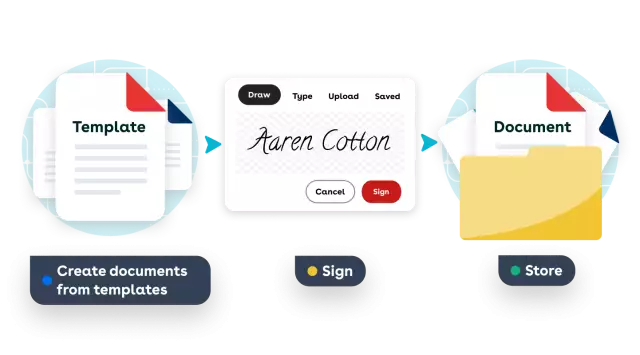
CONGA FOR IT DEPARTMENTS
Simplify IT processes and reduce involvement in day-to-day management
Support seamless integration, secure data handling, and compliance with Conga—built to lighten your team’s workload

Trusted by IT leaders for low-maintenance, secure solutions
Reduce demands on IT with automation
Tackle IT challenges with a single, secure, and scalable solution. Cut down on repetitive tasks, reduces risks, and fit solutions seamlessly into your tech stack so you can focus on driving innovation.
Unified technology
Integrate Conga for IT with your existing systems using cloud-first open APIs, SDKs, and partner extensions. Conga eliminates the complexity of disconnected systems, creating a unified tech ecosystem.
Easy for everyone
Give every team intuitive and easy-to-use solutions, so IT spends less time on training and troubleshooting. Conga helps departments adopt new software, freeing up time for the IT team to focus on strategic priorities.
Single solution
Reduce operational costs with Conga’s multitenant SaaS, a single platform that works across departments. Centralize tools, cut down maintenance, and let IT focus on what matters.
Streamline revenue processes without straining IT resources
The Conga Advantage Platform unifies Revenue & Commerce, CLM, and Document Automation to streamline processes, boost compliance, and enhance collaboration.
Streamline document creation with Document Automation
- Comprehensive document generation.
Create essential proposals, contracts, and invoices effortlessly. - Minimize organizational risks.
Ensure standardization and consistency across all documents. - Customizable and scalable solutions.
Tailor documents to fit your unique business requirements.

Optimized configuration and quoting processes
- Guided quoting support.
Enhance quoting precision for complex setups. - Automated renewal workflows.
Streamline contract renewals with tech integration. - Real-time pricing assistance.
Provide instant pricing for fast, accurate deals.

Conga integrates seamlessly for efficient IT processes
- Customizable integrations.
Connect Conga with your CRM and tools using APIs. - Collaboration-ready tools.
Enable quick access to shared insights for alignment. - Data synchronization.
Unified platform for seamless data collection and access.

Compliance made easier for IT, reducing risk
- Regulatory adherence.
Meet global compliance: SOC 2 Type II, ISO, FedRAMP. - Risk identification.
Manage risks proactively with automated workflows. - Audit-friendly tools.
Track audits and streamline compliance reporting.

Conga simplifies contract management for IT efficiency
- Standardized templates.
Global uniformity with pre-approved clauses. - Centralized contract management.
Accessible location enhances visibility and search speed. - Smart compliance automation.
Help teams spot and fix contract issues swiftly.

Scalable and reliable for future innovation
- Automatic updates.
Multitenant SaaS provides ongoing upgrades with no IT cost. - Downtime prevention.
Design infrastructure for reliable, enterprise-scale performance. - Robust Conga support.
Use Conga’s resources to resolve issues and access updates.

Streamline IT operations with the Conga Advantage Platform
- Centralized integration.
Streamline your system with unified cloud-first APIs. - User-centric design.
Empower teams with intuitive tools to reduce training needs. - Cost-effective solutions.
Centralize tools to cut operational costs effectively.

Outcomes that showcase Conga’s IT success
Improvement in compliance
Saved hours in implementation and setup
Verified data points
Become a more connected, intelligent business with seamless IT integration
Connect every part of your business on one platform to reduce silos, simplify workflows, and give teams the tools they need to move faster and make smarter data-driven decisions.
Enable smarter quoting and proposals
Empower sales teams to configure and price deals with built-in process automation, requiring minimal IT input.

Streamline workflows across processes
Connect revenue workflows on one platform to simplify contract management and fulfillment. Make sure every department works with reliable, accurate data.

Uncover new opportunities
Centralize contract and subscription data to help teams identify renewal and upsell opportunities.

Gain valuable insights into performance
Get insights to fix bottlenecks, improve workflows, and keep everything running smoothly throughout the revenue lifecycle.

Minimize IT workload with a single-platform solution
Every Conga solution is part of the Advantage Platform, creating a unified system to reduce complexity and support every department. Here’s how the IT department uses Conga products:
Boost IT operations and reduce manual work
Request a demo today to discover how Conga IT operations automation tools can help you simplify processes, connect systems, and deliver scalable solutions that support growth.
Frequently asked questions
-
How does Conga for IT handle system updates and maintenance?
Conga’s SaaS platform handles updates automatically, taking the burden off your team so you can focus on strategic innovation. With Conga, you get:
- Automatic updates: Always stay on the latest version without disruptions or compatibility issues.
- Centralized versioning: As multiple departments use the same version of the platform, IT teams don’t need to manage multiple software instances.
- Proactive monitoring: Conga continuously monitors system performance to identify and address potential issues before they impact business operations.
- Resource availability: Comprehensive release notes and support documentation provide your team with the information needed to use new and existing features.
-
Can Conga integrate seamlessly with our existing tech stack?
Absolutely. Conga works where you do. Our platform easily integrates with your current systems, no matter how complex they are.
- Open APIs: Connect with any CRM, ERP, and third-party tools with our accessible APIs.
- Cloud-agnostic delivery: Work on any cloud service, giving you the flexibility to use your existing infrastructure.
- Pre-built connectors: Make deployments fast with plug-and-play integrations with Salesforce, Microsoft Dynamics, and other major platforms.
- Data consistency: Keep data flowing across systems and teams with our single data model.
-
How does Conga support scalability for growing IT infrastructure needs?
The Conga Advantage Platform grows with you. Go from a simple setup to a complex enterprise environment without ever switching vendors. We make it possible with:
- Elastic infrastructure: Cloud-based scalability allows Conga to handle increasing data, transactions, and user demands without compromising performance.
- Support for diverse revenue streams: The platform accommodates every type of billing model—from traditional sales to subscriptions and usage-based.
- Modular solutions: Start with a single solution and add more as needed, creating a tailored platform that aligns with your growth strategy.
-
What user access controls are available to secure sensitive data?
Our platform keeps your data safe—that’s what makes Conga for IT departments special. Get control and compliance features, such as:
- Role-based permissions: Control who sees what by assigning access based on user roles and limiting exposure to sensitive information.
- Multi-factor authentication (MFA): Add an extra layer of security to protect user accounts.
- Comprehensive audit trails: Track all user activities, including data access and modifications, to maintain accountability and support compliance requirements.
- Certified security standards: Adhere to global data protection regulations such as SOC 2 Type II, ISO 27001, and FedRAMP.
-
Does Conga offer tools to monitor system performance and usage metrics?
Yes, Conga provides comprehensive IT reporting tools, like reports and dashboards, to evaluate and optimize system performance. Examples include:
- Real-time dashboards: Visualize system usage, spot bottlenecks, and monitor overall health—all in a single view.
- Performance analytics: Get actionable insights to improve workflows and identify inefficiencies.
- Reporting: Create custom and detailed reports on platform adoption, user activity, and ROI to guide strategic decisions.
- Proactive issue detection: Identify issues early and resolve them before they impact productivity and customer experiences.








